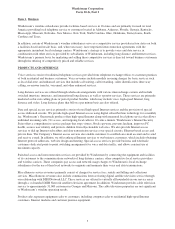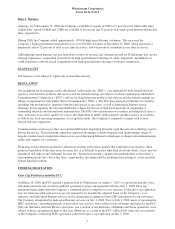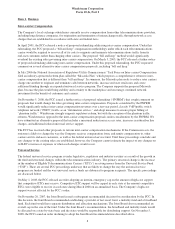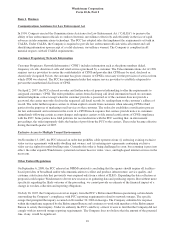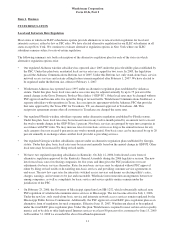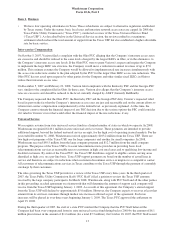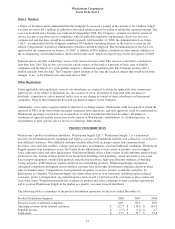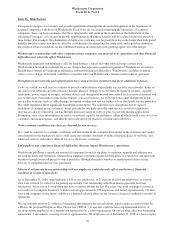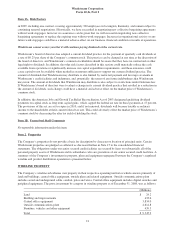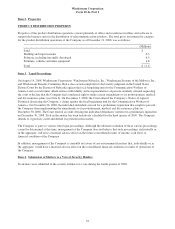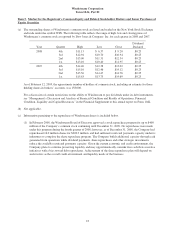Windstream 2008 Annual Report Download - page 61
Download and view the complete annual report
Please find page 61 of the 2008 Windstream annual report below. You can navigate through the pages in the report by either clicking on the pages listed below, or by using the keyword search tool below to find specific information within the annual report.
Windstream Corporation
Form 10-K, Part I
Item 1. Business
• We have four operating subsidiaries in Texas. These subsidiaries are subject to alternative regulation established
by Texas statute. Under the statute, basic local rates and intrastate network access rates are capped. In 2008 the
Texas Public Utility Commission (“Texas PUC”) conducted a review of the Texas Universal Service Fund
(“Texas USF”). As described below in the Universal Service section, the review resulted in a unanimous
settlement which reduced the total amount of support from the Texas USF but also established a higher affordable
rate for basic service.
Inter-carrier Compensation
On October 5, 2007, Verizon filed a complaint with the Ohio PUC alleging that the Company’s intrastate access rates
are excessive and should be reduced to the same levels charged by the largest ILECs in Ohio, or in the alternative, to
the Company’s interstate access rate levels. If the Ohio PUC were to grant Verizon’s request and require the Company
to implement the large ILEC rate structure, the Company would incur a reduction in annual revenues of up to $7.0
million. This estimate assumes the Company would be allowed to implement retail rate increases simultaneously with
the access rate reductions similar to the plan adopted by the PUC for the larger Ohio ILEC access rate reductions. The
Ohio PUC has not acted upon requests by other parties for the Company and other similar sized ILECs in Ohio to
reduce their intrastate access rates.
On December 5, 2007 and February 22, 2008, Verizon filed complaints with the Kentucky PSC and the Georgia PSC
very similar to the complaint filed in Ohio. In these cases, Verizon also alleges that the Company’s intrastate access
rates are excessive and should be reduced to the level currently charged by AT&T (formerly BellSouth).
The Company requested that the Ohio PUC, the Kentucky PSC and the Georgia PSC deny Verizon’s requested relief
based in part on the fact that the Company’s intrastate access rates are just and reasonable and on the current efforts to
reform inter-carrier compensation comprehensively at the federal level, as previously explained. At this time, the
Company cannot estimate the financial impact of any PSC decision due to the various options the PSC could consider
if it ruled in Verizon’s favor that would affect the financial impact of the rate reductions, if any.
Universal Service
We recognize revenue from state universal service funds in a limited number of states in which we operate. In 2008,
Windstream recognized $140.1 million in state universal service revenue. These payments are intended to provide
additional support, beyond the federal universal service receipts, for the high cost of operating in rural markets. For the
year ended December 31, 2008, Windstream received approximately $103.2 million from the Texas USF. There are
two high-cost programs of the Texas USF, one for large companies and another for small companies. In 2008,
Windstream received $90.5 million from the large company program and $12.7 million from the small company
program. The purpose of the Texas USF is to assist telecommunications providers in providing basic local
telecommunications services at reasonable rates to customers in high cost rural areas and to qualifying low-income and
disabled customers. By order of the Texas PUC, the Texas USF distributes support to eligible carriers serving areas
identified as high cost, on a per-line basis. Texas USF support payments are based on the number of actual lines in
service and therefore are subject to reductions when customers discontinue service or migrate to a competitive carrier.
All customers of telecommunications services in Texas contribute to the Texas USF through the payment of a monthly
surcharge by their customers.
The rules governing the Texas USF provide for a review of the Texas USF every three years. In the third quarter of
2007, the Texas Public Utility Commission Staff (“PUC Staff”) filed a petition to review the Texas USF amounts
received by the large company participants. In March 2008, Windstream, along with PUC Staff and all the other parties
in this proceeding, reached agreement on a framework that will determine the amount of support each company will
receive from the Texas USF beginning January 1, 2009. As a result of this agreement, the Company’s annual support
from the Texas USF will decline by approximately $5.0 million. However, the Company expects to recover at least that
amount from its end user customers through modest rate increases allowed as part of the agreement. Such rate
increases will be phased in over three years beginning January 1, 2009. The Texas PUC approved the settlement on
April 25, 2008.
During the third quarter of 2007, the staff of a state PUC notified the Company that the PUC Staff believed the
Company had been over-compensated from its state universal service fund dating back to 2000 by the amount of $6.1
million plus interest in the amount of $1.2 million (for a total $7.3 million). On October 18, 2007, the PUC Staff issued
13




